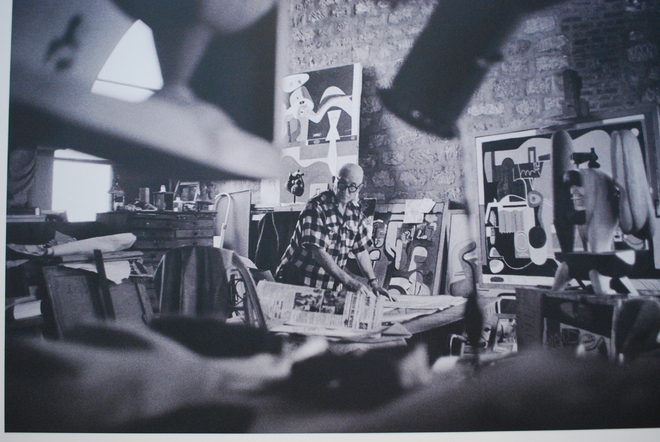
Le Corbusier in his studio (Courtesy: MoMA, New York)
Rajnish Wattas
On his first visit to Chandigarh site in February 1951, its Swiss-born, French architect-planner Le Corbusier was ecstatic. In lyrical tones he wrote to his wife, Yvonne, "I've never been so tranquil and solitary, absorbed by the poetry of natural things and by poetry itself…. We're on the site of our city under a splendid sky, in the midst of a timeless countryside…. Everything is calm, slow, harmonious, lovable, everyone addresses you in low, modulated tones."
Sometimes, perhaps ignorantly, his creations in Chandigarh are perceived as ‘Western impositions on Indian soil’ — which are quintessentially Indian in spirit, born out of deep study, observations and assimilation of the country’s ethos. His visits to historic Indian monuments became creative cues and inspirations for the repertory of his ideas and forms that he rigorously recorded and mined later for his designs.
His visits to Jantar Mantra, Delhi, and the Mughal Gardens, Pinjore, as well as the Rashtrapati Bhawan's Mughal Gardens, New Delhi, were, in fact, seed ideas, for his later creative expressions.
The rhythms of the arcaded, pillared hall of Diwan-i-Aam in the Red Fort, Delhi, later on got transformed into arches atop the parasol roof of the High Court building in the Capitol Complex at Chandigarh. Similarly, the enormous scale of the entrance portico of the High Court with giant pylons has echoes of the monumental scale of the Buland Darwaza at Fatehpur Sikri. The arches above the pylons also frame views of the distant Assembly building with its fascinating hyperbolic pyramidal roof; akin to the experience evoked by the arched gateways leading to most Mughal monuments.
If there was inspiration in the palaces, there were lessons in making climate-friendly dwellings in the humble huts of the poor villagers. Corbusier found inspiration in the vernacular architecture of the nearby villages of Chandigarh and admired their plasticity of form set in the bucolic, pastoral landscapes surrounding them.
He saw artistic richness in the decorative motifs made on the mud hut walls and the play of light and shadows cast by the small apertures and fenestrations inside. The interiors were cool and bathed in soft light while cutting off the piercing heat. He incorporated these ideas in the small openings seen in the ramps of the Secretariat that cast dappled shadows.
His copious sketches of the bull and its magnificent horns, was a form that almost obsessed him; and later got manifested in the bold curves of the canopy above the entrance portico of the Assembly building. The building material chosen for the Capitol buildings was concrete, as it was locally available and familiar to local builders and had the raw, brute aesthetic appeal that Corbusier called, "molten rock of the twentieth century". He conveyed its plasticity and ruggedness through exposed surfaces with motif designs ranging from Harappan seals, pastoral animals like bulls, cows and replicas of birds, fish often etched out by village labourers on wet concrete surfaces.
Dealing with the issue of hot and dry climate of Chandigarh was of great concern to Corbusier. He saw in the cascading waters, pools of the nearby Mughal Gardens at Pinjore, time-tested ways of natural air-conditioning. He similarly planned a playful series of water pools between the Governor's Palace and the remaining edifices to connect to the vastness of the main esplanade, and reduce the enormity of the scale.
The city plan, essentially a chequered grid, is criss-crossed by two major axes: the Jan Marg and the Madhya Marg, the former leading to the Capitol and the hills. Interestingly, the ancient Indian treatise Mansara’s Silpa Sastra, also codifies laying out of the two main streets laid out along the cardinal points as the cosmic cross, and the so-called magic square representing the four quarters of the universe.
The layout plan of Chandigarh presented by Corbusier with the anthropometric analogy of a human body with head, arms, heart and viscera has significant similarities with the plan of Jaipur, based on a grid of ancient Indian Navgrahas Mandala superimposed with the image of Vastupursha – the metaphysical being who resides at the site as an embodiment of the cosmic order with its head facing North-East. Chandigarh’s symbolic ‘head’ the Capitol Complex also faces the same orientation. Of course, there is documentary or historical proof about Corbusier knowing about this or intending it for such reasons. His own reasoning of placing the ‘crowning glory’ of the city there was to incorporate the backdrop of the magnificent hills in its settings.
Another strong Indian element at the Capitol Complex is his fixation with the symbol of sun (surya), as the primordial cosmic force that governs lives of human beings. As a salutation to its radiance, he painted it as a dazzling yellow orb moving across the arc of the horizon at the top of the 24 feet X 24 feet enamelled door, especially gifted by him for the ceremonial entrance of the Assembly.
On many a starlit night, it is said, that both Le Corbusier and P. L Varma, the erudite Chief Engineer of the Chandigarh project with a deep philosophical understanding of the ancient Indian thought, would engage on larger questions of cosmic forces, suffering, peace and human values, in a rare kinship of two kindred souls.
Was there a divine connect between the Frenchman from the Alps and the dry, dusty plains of Punjab — on whose soil he finally realised his most significant architectural moment?



























